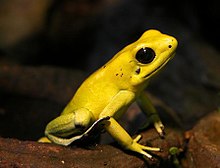
Back فيلوباتس ARZ Листолази Bulgarian Phyllobates Catalan Phyllobates CEB Blattsteiger German Phyllobates English Filobatoj Esperanto Phyllobates Spanish Phyllobates Basque قورباغههای زهرآگین طلایی Persian
| Phyllobates | |
|---|---|

| |
| P. terribilis | |
| Scientific classification | |
| Domain: | Eukaryota |
| Kingdom: | Animalia |
| Phylum: | Chordata |
| Class: | Amphibia |
| Order: | Anura |
| Family: | Dendrobatidae |
| Genus: | Phyllobates Duméril and Bibron, 1841 |
| Species | |
|
6, see text | |
Phyllobates is a group of frogs with poison in their skin. They live in Central America and South America, from Nicaragua to Colombia. There are three different Colombian species of Phyllobates. They have strong poison.
The most poisonous frog in the world is in Phyllobates: The golden poison frog (P. terribilis). All the frogs in Phyllobates have bright colors on their skins. This tells other animals not to eat the frog, even though some of them do not have poison. Native South Americans use Phyllobates frogs to put poison on the tools they use to hunt animals for food. The frogs' poison is made of alkaloids molecules, and the frogs make them in glands in their skins. The strongest poison is batrachotoxin.[1]
- ↑ Daly, J.W. (1995). The chemistry of poisons in amphibian skin. Proceedings of the National Academy of Sciences 92: 9-13.